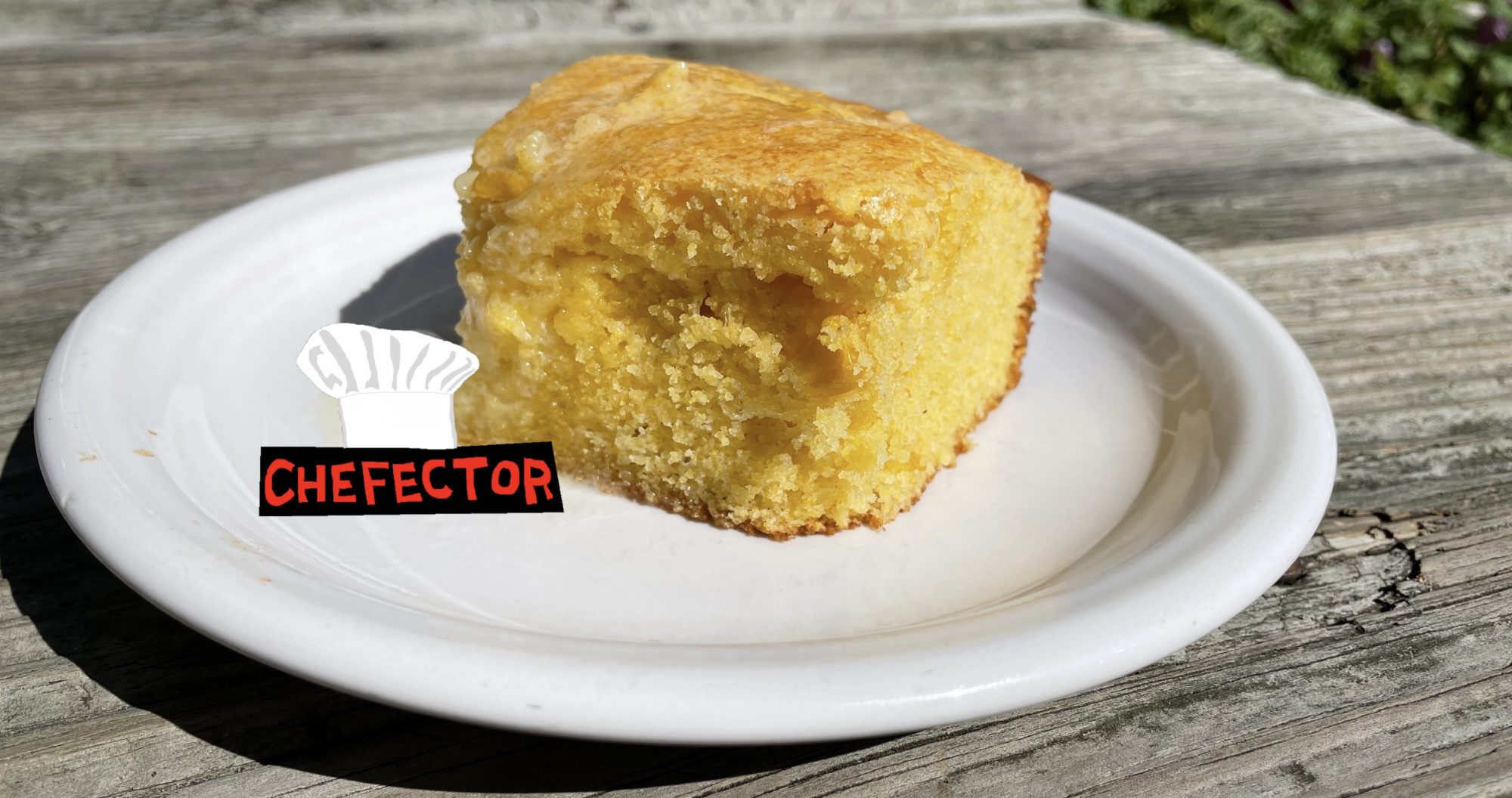It's lovely outside, here where I am, crystalline and cool. A giant dome of water vapor has cracked open and air is blowing through for the first time since April. It's good grilling weather; you can sit or stand within arm's reach of a hot charcoal kettle for hours without feeling sure you'll drop dead from heat stroke. I recommend: A cookout! And I recommend baking some cornbread to go with it.
Even if a cookout is not an option, cornbread is delicious and about as easy as baking projects get, and also corn's seasonality gives me a flimsy excuse to write a blog about baking cornbread right now, and thus a flimsy excuse to bake cornbread ("I'm fine-tuning it for the blog!"), and thus a flimsy excuse to eat cornbread, which I want to do even though my wheezing pancreas almost certainly would prefer more healthful choices, such as nearly any other thing to eat. Your part in this whole deal is to be a receptacle for these recommendations. I sincerely hope you'll bake some cornbread, but I know for a fact that I will bake some cornbread. Let's bake some cornbread.
Here are some things that you will need.
You will need some coarsely ground cornmeal. A cup of the stuff. Cornbread doesn't particularly care whether you make it using white or yellow cornmeal; blindfolded, you almost certainly couldn't differentiate the two. The day before I made the pretty yellow cornbread in the photo at the top of this blog, I made cornbread with white cornmeal that was every bit as delicious. Both were delicious! Cornbread is delicious. But the former cornbread was not pretty, because it was not yellow. It didn't look like cornbread. It looked like poundcake. That matters to me. I recommend yellow cornmeal.
You will need some all-purpose flour. A cup of it! I can feel some readers' hackles rising at this. I know they're out there, offended by the notion of a 1:1 ratio of cornmeal to flour in something that dares do business as "cornbread." Cornbread, after all, traces its origins to times and places when wheat flour cost more than cornmeal, and to people who could afford the latter but not the former. The whole idea was, here's this tasty thing we invented downstream of the inability to make bread out of flour. That's a perfectly fine reason to prefer making cornbread without flour, if that's how you want to do it, or with less flour.
My rejoinder here is that I like it better this way: It hangs together better, it's lighter in texture and less grainy. My hunch is that cornbread's inventors would have included flour if they could have! In any event, we're proceeding from here as though you're including the dang flour.
You will also need—or anyway your cornbread will welcome—some corn. But it already has corn in it, you are saying. It has the cornmeal. Is this some type of overcompensation for having diluted the corn with flour? No, it is not! You can go to hell for suggesting such a thing! I am simply telling you that your cornbread will be better, more exciting on a bite-to-bite basis, if it is studded here and there with some sweet kernels of corn. A nice big fistful of these will do, for the proportions we're working with. You can, like, cook an ear of corn and then shave off the kernels with a kitchen knife, or you can nuke a bag of frozen corn and setting aside a fistful of the corn. If you go the latter route, I recommend pressing the corn between two layers of paper towels to press out the excess liquid. This is a baking preparation, after all, and baking projects are finicky about volumes of liquid.
You will need some sugar. Cornbread is not super particular about how much. You can use half a cup of sugar to turn out very sweet, dessert-like cornbread that nevertheless will do spectacular work as a mop for chili. You can use a quarter-cup of sugar for cornbread that, uh, is less sweet than that. If your preferred thing to do with cornbread is to, say, slather it with honey and butter (amazing!), maybe you would like the cornbread less sweet on its own, for the sake of balance. The main thing is, cornmeal is not as sweet as the corn you eat off of a cob. No ratio of cornmeal to flour will make cornbread that tastes like sweet corn unless you add some sugar to help to bring out its, ah, corniness.
You'll need salt. This can be regular table salt. If you're using half a cup of sugar, use two teaspoons of salt for balance; if you're using less sugar, use less salt, but definitely use at least a teaspoon of it. You will also need three teaspoons of baking powder. Many cornbread recipes out there go for some quantity of baking soda instead of powder (and thus buttermilk instead of the whole milk I haven't told you about yet), but it simplifies things not to need the acidity of buttermilk to activate the baking soda because, let's be realistic here, you are likelier to have regular milk on hand. Therefore: baking powder. That's it for the dry ingredients. If you interrupt this blog to dispute whether the corn kernels qualify as "dry," so help me I will scream.
The wet stuff! You will need some milk, as hinted above. Two-thirds of a cup of whole milk will be grand. You will need two eggs. And you will need half a cup of some liquid cooking fat. Now, listen. I am not going to get into a whole friggin' thing about the nature of this liquid cooking fat. If you have opinions about whether only a low-down scumbag would use vegetable oil in cornbread, go right on having them. What I will say is that if your preferred cooking fat is one that will not be liquid at room temperature (if it is, say, butter, or ghee, or lovingly rendered bacon grease or whatever), then you will have to follow some other set of instructions for making cornbread. For our purposes here today—those purposes being, taken altogether, the happiest possible compromise between deliciousness and ease of production—vegetable oil is fine. I recommend it. That is it for the wet stuff.
You will also need some means of greasing a baking pan. This is where butter is great, but you can use cooking spray too. I don't care!
(One last thing: I have mentioned and then ducked past butter twice already. But it is good to have some room-temperature butter on standby. When the cornbread comes out of the oven all hot and delicious-smelling, the reason will become as obvious to you as if God shouted it from the sky.)
As for non-ingredient stuff, I am very happy to say that you most definitely do not need a stand mixer or hand mixer or any other fancy type of mixer for this. You need one fork and one silicone spatula (ideal) or wooden spoon (not ideal but fine) or, what the hell, a clean, unused, and unscented orthopedic shoe insert, I mean I am not eating this cornbread, it doesn't particularly matter to me how you go about putting it together. You need two bowls, one genuinely large and the other maybe not as large. And you need, if you had not figured it out, a baking pan. I strongly recommend that this be a 9-inch-diameter, 2-inch-depth round cake pan of the sort they sell in the cake-mix aisle at every normal supermarket; if you can't find one of those, then something close to it in dimensions, or else I really do not know how your cornbread will turn out. Happily, many normal-sized oven-proof skillets are close to those dimensions. You can probably use one of those if you can't find a cake pan. Naturally you will need a functioning oven.
Can we cook already? Let's cook.
The cooking part is very straightforward. Preheat your oven to 400 degrees. Also, grease that baking pan.
You have the two bowls, yes? The large one and the not-as-large one. (They can also be two large ones. I can't really think of a circumstance in which a bowl can be too large for a baking project, unless it's too big to fit in the same building as the oven. Where would you even get such a bowl? Why would you? Why did you do that???) In the large bowl, combine all the dry ingredients. Stir them together with the fork so that they're all evenly mixed together. In the other bowl, combine the wet ingredients. Doing the dry ingredients first was smart; now you can use the same fork to beat the wet ingredients together until they're fully mixed without worrying that the fork is wet now and will make a bad instrument for combining the dry ingredients. Good job.
Now, dump the wet-ingredient mixture into the bowl with the dry-ingredient mixture. Using the flexible spatula or wooden spoon, gently fold this stuff together just until you have an even mixture and there are no hidden pockets of dry stuff anywhere, and absolutely not any more than that. The reason is that the more you agitate this stuff, the more the gluten in the flour will develop, giving you a chewier, more breadlike end product. Yes, it is called cornbread, and the whole reason to include the flour was that it helps the cornbread hang together better—but c'mon, you are not making a turkey club sandwich with this stuff. It's fine for cornbread to hang together a little bit, so that you can handle it without it instantaneously flying apart at a molecular level; it is not fine for cornbread to be chewy like a baguette.
Is the oven hot yet? Great. Scoop the somewhere-between-dough-and-batter into the greased baking pan, slide the baking pan into the hot oven, close the oven, and set a timer for 25 minutes. That was it. That was all the cooking.
Time is funny. Twenty minutes is no time at all when 20 minutes from now you must host a live webinar for clients, in which you alone will train them to use the geographic information system software module that, whoops, ha ha, turns out you forgot to so much as install on your laptop at any point during the six months you were expected to completely master it, and 21.5 minutes from now you will probably be looking for a new job. But 20 minutes is a lifetime when, five minutes after you slide that pan into the oven, the smell of baking cornbread fills your kitchen, and you must sit on your hands at the farthest corner of your home to keep yourself from doing a head-first baseball slide into your 400-degree oven to wear that nascent cornbread like a goddamn hat. Resist! Wear an N95 mask to take the edge off the aromas! You can do it!
Eons later, a thousand billion lifetimes of the universe later, the 25-minute timer will go off. Now you may extract the cornbread from the oven (with oven mitts! I should have told you you'd need oven mitts!) put a clean kitchen towel over it, and set yet another timer, for 10 horrible, horrible minutes. I promise this is the last timer.
Later you can pair the cornbread with chili, barbecue, honey, or whatever. In the meantime, cut out a hunk while it's still hot, spread some of that room-temperature butter on top, and fire it dow—
Wow. The whole pan. Holy smokes. You didn't even chew. I can't look at you right now.







